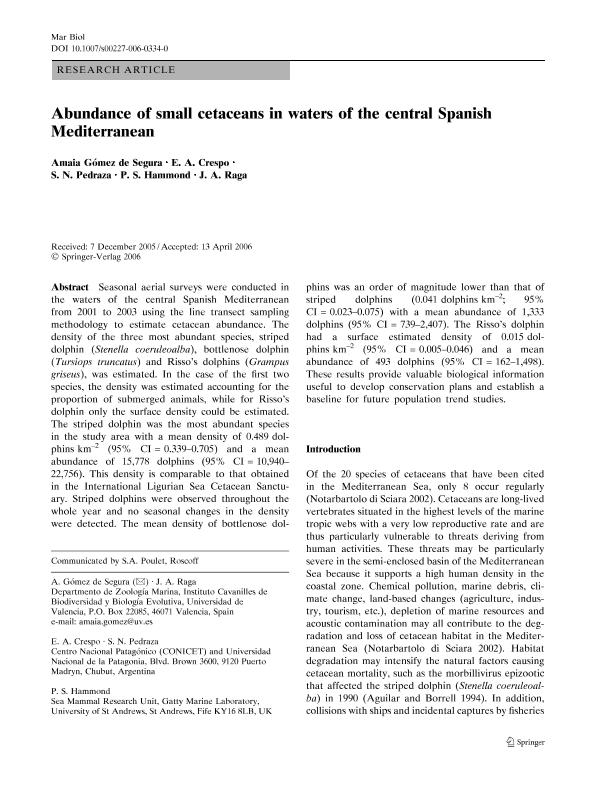Mostrar el registro sencillo del ítem
dc.contributor.author
Gómez de Segura, Amaia
dc.contributor.author
Crespo, Enrique Alberto

dc.contributor.author
Pedraza, Susana Noemi

dc.contributor.author
Hammond, P. S.
dc.contributor.author
Raga, J. A.
dc.date.available
2020-04-29T13:52:27Z
dc.date.issued
2006-05
dc.identifier.citation
Gómez de Segura, Amaia; Crespo, Enrique Alberto; Pedraza, Susana Noemi; Hammond, P. S.; Raga, J. A.; Abundance of small cetaceans in waters of the central Spanish Mediterranean; Springer; Marine Biology; 150; 1; 5-2006; 149-160
dc.identifier.issn
0025-3162
dc.identifier.uri
http://hdl.handle.net/11336/103883
dc.description.abstract
Seasonal aerial surveys were conducted in the waters of the central Spanish Mediterranean from 2001 to 2003 using line transect sampling methodology to estimate cetacean abundance. The density of the three most abundant species, striped dolphin (Stenella coeruleoalba), bottlenose dolphin (Tursiops truncatus) and Risso’s dolphins (Grampus griseus) was estimated. In the case of the first two species, density was estimated accounting for the proportion of submerged animals, while for Risso’s dolphin only the surface density could be estimated. The striped dolphin was the most abundant species in the study area with a mean density of 0.489 dolphins km-2 (95% CI = 0.339 - 0.705) and a mean abundance of 15,778 dolphins (95% CI = 10,940 - 22,756). This density is comparable to that obtained in the International Ligurian Sea Cetacean Sanctuary. Striped dolphins were observed throughout the whole year and no seasonal changes in density were detected. The mean density of bottlenose dolphins was an order of magnitude lower than that of striped dolphin (0.041 dolphins km-2; 95% CI = 0.023 - 0.075) with a mean abundance of 1,333 dolphins (95% CI = 739 - 2,407). The Risso’s dolphin had a surface estimated density of 0.015 dolphins km-2 (95% CI = 0.005 - 0.046) and a mean abundance of 493 dolphins (95% CI = 162 - 1,498). These results provide valuable biological information useful to develop conservation plans and establish a baseline for future population trends studies.
dc.format
application/pdf
dc.language.iso
eng
dc.publisher
Springer
dc.rights
info:eu-repo/semantics/openAccess
dc.rights.uri
https://creativecommons.org/licenses/by-nc-sa/2.5/ar/
dc.subject
BOTTLENOSE DOLPHIN
dc.subject
DETECTION FUNCTION
dc.subject
AERIAL SURVEY
dc.subject
SCHOOL SIZE
dc.subject
SMALL SCHOOL
dc.subject.classification
Ecología

dc.subject.classification
Ciencias Biológicas

dc.subject.classification
CIENCIAS NATURALES Y EXACTAS

dc.title
Abundance of small cetaceans in waters of the central Spanish Mediterranean
dc.type
info:eu-repo/semantics/article
dc.type
info:ar-repo/semantics/artículo
dc.type
info:eu-repo/semantics/publishedVersion
dc.date.updated
2020-04-06T16:05:26Z
dc.identifier.eissn
1432-1793
dc.journal.volume
150
dc.journal.number
1
dc.journal.pagination
149-160
dc.journal.pais
Alemania

dc.description.fil
Fil: Gómez de Segura, Amaia. Universidad de Valencia; España
dc.description.fil
Fil: Crespo, Enrique Alberto. Consejo Nacional de Investigaciones Científicas y Técnicas. Centro Científico Tecnológico Conicet - Centro Nacional Patagónico; Argentina
dc.description.fil
Fil: Pedraza, Susana Noemi. Universidad Nacional de la Patagonia "San Juan Bosco"; Argentina. Consejo Nacional de Investigaciones Científicas y Técnicas. Centro Científico Tecnológico Conicet - Centro Nacional Patagónico; Argentina
dc.description.fil
Fil: Hammond, P. S.. University of St. Andrews; Reino Unido
dc.description.fil
Fil: Raga, J. A.. Universidad de Valencia; España
dc.journal.title
Marine Biology
dc.relation.alternativeid
info:eu-repo/semantics/altIdentifier/url/https://link.springer.com/article/10.1007%2Fs00227-006-0334-0
dc.relation.alternativeid
info:eu-repo/semantics/altIdentifier/doi/https://doi.org/10.1007/s00227-006-0334-0
Archivos asociados
